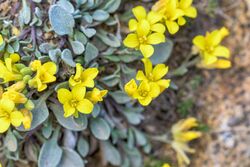Biology:Physaria humilis
| Physaria humilis | |
|---|---|

| |
| Scientific classification | |
| Kingdom: | Plantae |
| Clade: | Tracheophytes |
| Clade: | Angiosperms |
| Clade: | Eudicots |
| Clade: | Rosids |
| Order: | Brassicales |
| Family: | Brassicaceae |
| Genus: | Physaria |
| Species: | P. humilis
|
| Binomial name | |
| Physaria humilis (Rollins) O'Kane & Al-Shehbaz[1]
| |
| Synonyms | |
|
Lesquerella humilis Rollins | |
Physaria humilis, the St. Marys Peak bladderpod[2] or Bitterroot bladderpod, is a species within the family Brassicaceae that is endemic to the Bitterroot Mountains of Montana.
Range
Montana endemic restricted to a very small area of the Bitterroot Mountains of Ravalli County, Montana with only a few known occurrences.[3]
Habitat
Rocky, granite-derived soil on open slopes, primarily in the subalpine and alpine zones.[4]
Ecology
Flowers in late June-August, fruiting in July-August.
Etymology
Physaria humilis (originally known as Lesquerella humilis) was formerly described as a species in 1984 by Dr. Reed Rollins. It was first discovered on St. Joseph Peak in the Bitterroot Range in 1966, by Klaus H. Lackschewitz and Tor Fageraas. This first specimen, and other early collections, were variously labeled as Lesguerella alpina, Physaria didvmocarpa, or P. geveri, but Rollins ultimately determined that they represented a previously undescribed species. The type specimen was collected in 1983 by Reed C. and Kathryn W. Rollins, with Lackschewitz, Peter Lesica, and Aileen G. Roads, near the summit of St. Mary Peak, also in the Bitterroot Range. [3]
References
- ↑ "Physaria humilis (Rollins) O'Kane & Al-Shehbaz | Plants of the World Online | Kew Science" (in en). https://powo.science.kew.org/taxon/urn%3Alsid%3Aipni.org%3Anames%3A1125431-2.
- ↑ "St. Marys Peak Bladderpod (Physaria humilis)" (in en-US). https://www.inaturalist.org/taxa/359658-Physaria-humilis.
- ↑ 3.0 3.1 Achuff, P. L. (March 19, 1990). "Report on the conservation status of Lesquerella humilis, a candidate threatened species". Helena, Montana : Montana Natural Heritage Program. http://archive.org/details/1042086501MTn.
- ↑ Lackschewitz, Klaus. "Vascular Plants of West-Central Montana— Identification Guidebook". https://www.fs.usda.gov/rm/pubs_int/int_gtr277.pdf.
Wikidata ☰ Q15547588 entry
 |

